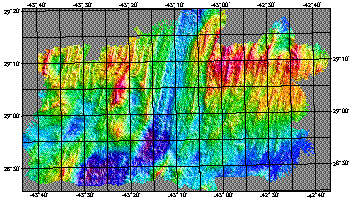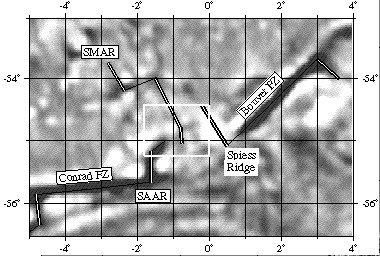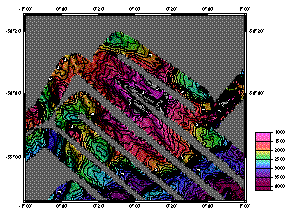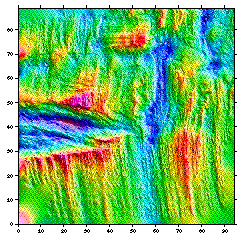Collaborators: Patience Cowie, Javier Escartin and Simon Allerton (Edinburgh), Chris MacLeod (Cardiff), Roger Searle and Peter Slootweg (Durham) and Team TOBI (Southampton).

|
Although we know that faulting at mid-ocean ridges occurs
near the ridge axes, we know very few further details on
the timing of fault growth, which is important for understanding
their mechanical behaviour. Unfortunately there are few ways of dating fault
motion over the bare volcanic rock of ridges, as traditional methods based
on stratigraphy, which are useful for understanding
sedimentary basin evolution, cannot usually be applied.
We collected high-resolution CHIRP sediment
profiler records from Thingvallavatn lake in Iceland,
which crosses Iceland's main western rift zone,
in order to attempt to infer fault evolution from the lake sediments.
The records and sidescan sonar images collected during the
same survey also show details of fracturing in the lake
floor and changes in sediment deposition probably
related to changes in water circulation in the lake.
Collaborators: Jon Bull, Justin Dix, Angus Best and Tim
Minshull (Southampton) and Kjartan Thors (Reykjavik).
|

|
| This project, funded by the NERC, was concerned with the junction between South America, Africa and Antarctica, which occurs near Bouvet Island. We mapped its structure using sidescan sonar images and bathymetry collected using the University of Hawaii HMR1 system aboard the British Antarctic Survey ship James Clark Ross in 1995. Because the velocity-space diagram for the relative plate motions is almost an isosceles triangle near Bouvet, some authors have speculated that the triple junction may be a ridge-fault-fault type (with the Mid-Atlantic Ridge terminating at two transform faults). |

|
|
The upper figure is an image of the gravity field
around the triple junction from satellite altimetry data
(Sandwell and Smith, 1997) with plate boundaries shown.
The lower figure is bathymetry over the triple
junction and Spiess Ridge, a giant volcanic structure (abstract and full article (PDF)*).
The growth of Spiess Ridge adjacent to the triple junction has led to peculiar deformation around it which does not obviously fit either the RRR or RFF models (abstract). Our surveying just north of the Bouvet and Conrad transform valleys, however, showed that the triple junction did probably evolve as a simple RFF for a few millions of years. Interestingly the Mid-Atlantic Ridge fabrics created during that RFF evolution are now over-printed by a massive oblique extensional faults, possibly representing the largest zone of transtensional deformation found so far in the oceans (abstract and full article (PDF)*). Collaborators: Roy Livermore (British Antarctic Survey), Enrico Bonatti, Marco Ligi, Paola Fabretti and Gabriela Carrara (ISMAR, CNR, Bologna, Italy)
|

|
The Rodriguez or Indian Ocean triple junction The Rodriguez junction between Africa, Antarctica and Australia is arguably
the simplest of the oceanic triple junctions, with three spreading
ridges almost meeting at a discrete point. The triple junction consists
of two medium spreading ridges and one slow spreading ridge (the
Southwest Indian Ridge). GLORIA sidescan sonar and French Sea Beam bathymetry
data
suggest that the two medium spreading ridges almost form one
continuous ridge. Seafloor created by them is slowly rifted by the
slow extension of the Southwest Indian Ridge, producing a
progressively broadening and deepening rift. The image to the
right shows Sea Beam bathymetry data from the triple junction,
courtesy of R. Schlich and M. Munchy, IPG Strasbourg, and illustrates
the broadening SWIR rift valley (on the left) away from the
roughly N-S Central Indian and Southeast Indian
Ridge rift valleys. Abstract
The Rodriguez junction between Africa, Antarctica and Australia is arguably
the simplest of the oceanic triple junctions, with three spreading
ridges almost meeting at a discrete point. The triple junction consists
of two medium spreading ridges and one slow spreading ridge (the
Southwest Indian Ridge). GLORIA sidescan sonar and French Sea Beam bathymetry
data
suggest that the two medium spreading ridges almost form one
continuous ridge. Seafloor created by them is slowly rifted by the
slow extension of the Southwest Indian Ridge, producing a
progressively broadening and deepening rift. The image to the
right shows Sea Beam bathymetry data from the triple junction,
courtesy of R. Schlich and M. Munchy, IPG Strasbourg, and illustrates
the broadening SWIR rift valley (on the left) away from the
roughly N-S Central Indian and Southeast Indian
Ridge rift valleys. Abstract
 A view of the triple junction from the east, showing the uplifted rift flanks of the Southwest Indian Ridge.
A view of the triple junction from the east, showing the uplifted rift flanks of the Southwest Indian Ridge.
This work was carried out when I was a graduate student with thesis advisors John Dewey (Oxford) and Lindsay Parson (SOC). |